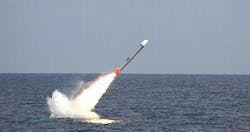Raytheon to provide another 114 advanced Tomahawk cruise missiles in $122.4 million contract
PATUXENT RIVER NAS, Md., 27 Feb. 2015. Munitions experts at the Raytheon Co. (NYSE:RTN) will build 114 Tomahawk Block IV long-range cruise missiles for the U.S. Navy under terms of a contract announced Thursday.
Officials of the Naval Air Systems Command at Patuxent River Naval Air Station, Md., are asking The Raytheon Missile Systems segment in Tucson, Ariz., to build the advanced surface ship- and submarine-launched cruise missiles under terms of a $122.4 million contract.
The RGM/UGM-109E Tomahawk Land Attack Missile (TLAM Block IV) is one of the latest versions of the 1970s-vintage Tomahawk cruise missile with digital scene matching area correlator system and improved turbofan engine. The subsonic long-range cruise missile is designed to attack targets on land, as well as large hardened warships.
Raytheon won a $139.2 million order last month to build 100 Tomahawk Block IV missiles. Last September Raytheon also won a $251.1 million order to build 231 Tomahawk Block IV all-up-round missiles shortly after U.S. forces fired 40-plus Tomahawks at terrorist targets in the Middle East.
The cruise missile, which can attack targets from as far away as 900 nautical miles, can be controlled in flight, and has a real-time targeting system for striking moving targets. Controllers reprogram the missile in flight to sent it to alternate targets preprogrammed before launch, or redirect it to a new target.
The Tomahawk Block IV missile is capable of launch from surface ships equipped with the vertical launch system (VLS), from submarines equipped with the capsule launch system (CLS), and from submarines equipped with the torpedo tube launch system.
The Tomahawk Block IV has a two-way satellite data link that enables the missile to respond to changing battlefield conditions. The missile can loiter over the battlefield to wait for the most valuable target to attack, and can transmit battle damage indication imagery and missile health, as well as status messages, the weapon's satellite data link. The missile also can fly GPS-only missions.
The Block IV Tomahawk has an anti-jam capability, a 1,000-pound warhead of either high explosives, polymer-bonded explosives, or the BLU-97/B combined effects weapon with independent bomblets designed to cause fragmentation and incendiary damage to enemy fighters, supply depots, and vehicles.
On the contract modification announced this week, Raytheon will do the work in Tucson, Ariz.; Camden and Berryville, Ark.; Ogden, Utah; Anniston and Huntsville, Ala.; Glenrothes, Scotland; Minneapolis; Fort Wayne, Ind.; Spanish Fork, Utah; Vergennes, Vt.; Ontario and El Segundo, Calif.; Westminster, Colo.; Walled Lake, Mich.; Middletown, Conn.; Dallas; Farmington, N.M.; and other locations, and should be finished by August 2017.
For more information contact Raytheon Missile Systems online at www.raytheon.com, or Naval Air Systems Command at www.navair.navy.mil.

